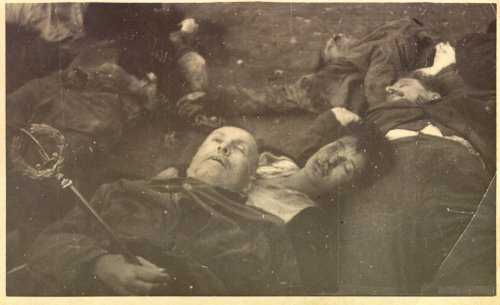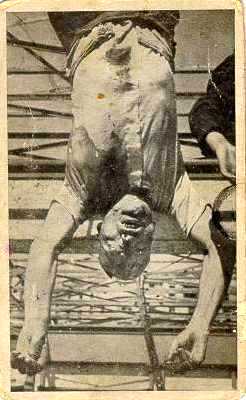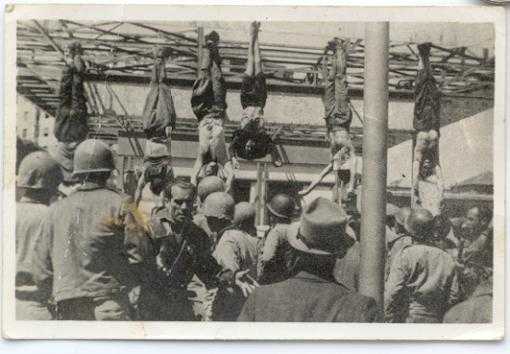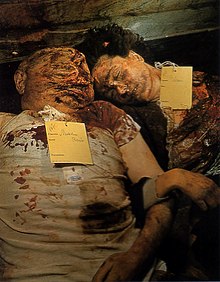Mussolini Death Photos Biography
Source:- Google.com.pkBorn in 1883 in Dovia di Predappio, Forlì, Italy, Benito Mussolini was an ardent socialist as a youth, following in hisfather's political footsteps, but was expelled by the party for his support of World War I. In 1919, he created the Fascist Party, eventually making himself dictator and holding all the power in Italy. He overextended his forces during World War II and was eventually killed by his own people, on April 28, 1945, in Mezzegra, Italy.
Early Life
Born on July 29, 1883, in Dovia di Predappio, Forlì, Italy, Benito Amilcare Andrea Mussolini was the eldest of three children. His father, Alessandro, was a blacksmith and an impassioned socialist who spent much of his time on politics and much of his money on his mistress. His mother, Rosa (Maltoni), was a devout Catholic schoolteacher who provided the family with some stability and income.
As a youth, Benito Mussolini showed much intelligence, but was boisterous and disobedient. His father instilled in him a passion for socialist politics and a defiance against authority. Though he was expelled from several schools for bullying and defying school authorities, he eventually obtained a teaching certificate in 1901 and, for a brief time, worked as a schoolmaster.
Impassioned Socialist
In 1902, Benito Mussolini moved to Switzerland to promote socialism, and quickly gained a reputation for his magnetism and remarkable rhetorical talents. While engaging in political demonstrations, he caught the attention of Swiss authorities and was eventually expelled from the country. In 1904, Mussolini returned to Italy and continued promoting a socialist agenda. He was briefly imprisoned and, upon release, became editor of the organization's newspaper, Avanti (meaning "Forward"), which gave him a larger megaphone and expanded his influence.
The Break with Socialism and Rise to Power
Mussolini initially condemned Italy's entry into World War I, but soon saw the war as an opportunity for his country to become a great power. His change in attitude broke ties with fellow socialists, however, and he was expelled from the organization. He joined the Italian army in 1915 and fought on the front lines, reaching the rank of corporal before being wounded and discharged from the military.
After the war, Mussolini resumed his political activities, criticizing the Italian government for weakness at the Treaty of Versailles. He organized several right-wing groups into a single force and, in March 1919, formed the Fascist Party—the movement proclaimed opposition to social class discrimination and supported nationalist sentiments, hoping to raise Italy to levels of its great Roman past.
Capitalizing on public discontent, Mussolini organized a para-military unit known as the "Black Shirts," who terrorized political opponents and helped increase Fascist influence. By 1922, as Italy slipped into political chaos, Mussolini declared that only he could restore order and was given the authority. He gradually dismantled all democratic institutions,and by 1929, had made himself dictator, taking the title "Il Duce" ("the Leader"). To his credit, Mussolini carried out an extensive public works program and reduced unemployment, making him very popular with the people.
Military Exploits
In 1935, determined to show the strength of his regime, Benito Mussolini invaded Ethiopia. The ill-equipped Ethiopians were no match for Italy's modern tanks and airplanes, and the capital, Addis Ababa, was quickly captured. Mussolini incorporated Ethiopia into the new Italian Empire. In 1939, he sent support to Fascists in Spain during the Spanish Civil War, hoping to expand his influence.Impressed with Italy's early military successes,
German dictator Adolf Hitler sought to establish a relationship with Benito Mussolini; he was flattered by Hitler's overtures and interpreted the recent diplomatic and military victories as proof of his genius. By 1939, the two countries had signed a military alliance known as the "Pact of Steel." Influenced by Hitler, Mussolini instituted discrimination policies against the Jews in Italy. In 1940, Italy invaded Greece with some initial success.
With Italy's resources stretched to capacity, many Italians believed the alliance with Germany would provide time to regroup. But Hitler's invasion of Poland and declaration of war with Britain and France forced Italy into war, and exposedweaknesses in its military. Greece and North Africa soon fell, and only German military intervention in early 1941 saved Mussolini from a military coup.
Italy's Defeat and Mussolini's Demise
In 1942, at the Casablanca Conference, Winston Churchill and Franklin D. Roosevelt devised a plan to take Italy out of the war and force Germany to move its troops to the Eastern Front against the Soviet Union. Allied forces secured a beachhead in Sicily and began marching up the Italian peninsula. With pressure mounting, Mussolini was forced to resign and arrested; German commandos later rescued him. Mussolini then moved his government to northern Italy, hoping to regain his influence. On June 4, 1944, Rome was liberated by Allied forces, who marched on to take control of Italy.
Mussolini and his mistress, Claretta Petacci, attempted to escape to Switzerland, but were captured by the Italian underground on April 27, 1945. They were executed the following day, on April 28, 1945, in Mezzegra (near Dongo), Italy, and their bodies were hung on display in a Milan plaza. The Italian masses greeted Mussolini's death without regret. Mussolini had promised his people Roman glory, but his megalomania had overcome his common sense, bringing them only warand misery.









No comments:
Post a Comment